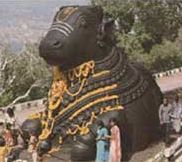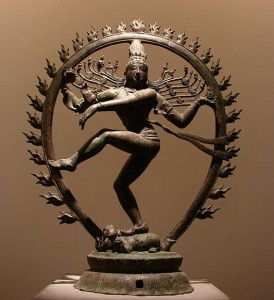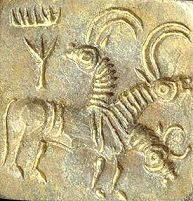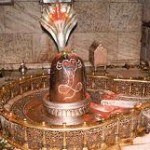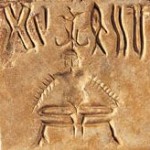Vac or word or sound is an important and vital factor in Indian psychology. The origin of speech receives considerable attention simply because all revelation is admitted as verbal inspiration and is transmitted through verbal instruction. There is an occult potency in sound as a form producer, not merely on the physical plane but also on the higher planes of life with which we are as yet little acquainted. The Logos is the embodiment of thought or idea of the cosmos. It exists in the mind of the Godhead and as such it is the cosmos in its wholeness and completeness, not as a time process nor as extended in three dimensional space or even in space-time, but in that unitary consciousness which may be reached in transcendental experience. As explained by H.H.Shri Kumarswamiji in the following article, Shiva-yoga raises the capacity of mind to respond to higher vibrations, to receive and assimilate a vast number of movements that are going on in the universe. In fact, it makes one a broadcasting as well as a receiving station of radio-activity with mind as the aerial.
In the course of time Yoga came to have a variety of meanings. It means method or discipline. It is often used in the sense of yoking. It also means tapas or austerities, dhyana or meditation. It signifies restraint of the senses and mind. Though it is sometimes used as a synonym for ecstatic trance or samadhi, it is more often employed to indicate the way of reaching it. According to the Rigveda, meditation on the Divine Light is a sacred act of devotion. In the Atharva Veda it is said that supernatural powers can be obtained through the practices of the austerities. The Upanishads regard Tapas and Brahmacharya as virtues productive of great power. The Svetasvetara Upanishad definitely refers to Yoga as the practical side of realization. Mahavira and Buddha underwent ascetic austerities and practised the highest contemplation. The Buddhist Sutras as well as Jaina Agamas are familiar with all the Yoga methods of concentration. The Mahabharat also refers to yoga. Many of the ascetics of the epic resort to yoga as a means of acquiring supernatural powers. Thus the Upanishads, the Mahabharat inlcuding the Bhagavad Gita, Jainism and Buddhism – all accept Yoga practices.
It is generally believed that Yoga is not so much a system of philosophy as a school of mysticism and magic. The Yoga concept of the self as a transcendent subject which is quite distinct from the body, mind and ego, is far removed from the common sense and the ordinary psychological concepts. As compared with these, the spiritual concept of self in Yoga is apt to be forgotten. Similarly, the supernatural powers associated with different stages in the practice of Yoga can hardly be reconciled with the known laws, physical or psychical sciences. But it is to be remembered that the Yoga scheme of self-realization has a solid foundation in metaphysics which proves the reality of the self as an eternal principle of consciousness. If one believes in the transcendent self, one cannot but admit that there are deeper levels of consciousness than the empirical one and wider possibilities and higher potencies than those of the sensuous. The society for pshychical research and the modern school of psychoanalisys have of late contributed much towards our knowledge about the dark regions of the psychical life hidden from the ordinary view. Yoga goes much further in the same direction, for not only does it explore the deeper regions of the supernatural but also formulates certain practical methods of purification and self-control for the realization fo the self in man.
Dr. S. Radhakrishnan briefly said this about Yoga: “In Yoga we have all reservoirs of life to draw upon of which we do not dream. It formulates the method of getting out our deeper functional levels. The Yoga discipline is nothing more than the purification of the body, mind and soul and preparing them for the beatific vision. Since the life of man depends upon the nature of chitta, it is always within our reach to transform our nature by controlling our chitta with faith and concentration. We can even rid ourselves of our ills. The normal limits of the human vision are not the limits of the universe. There are other worlds than those which our senses reveal to us, other senses than those which we share with the larger animals, other forces than those of material nature. If we have faith in the soul, then the supernatural is also a part of the natural.
Most of us go through life with eyes half-shut and with dull minds and heavy hearts, and even the few who have had these rare moments of vision and awakening, fall back quickly into somnolence. It is good to know that the ancient thinkers required us to realize the possibilities of the soul in solitude and silence and transform the flashing and fading movements of vision into a steady light which could illumine the long years of life”.
Vac or word is an important and vital factor in Indian psychology. The origin of speech receives considerable attention simply because all revelation is admitted as verbal inspiration and is transmitted through verbal instruction. Vac is actually made flesh in the different religious speculations, for out of it all creation is supposed to proceed. The Shivagamas, the Tantras and Vaishnava Samhitas – all have their respective theories of Vac or Nada from which the world is supposed to have arisen. Vac is Shabda-Brahma which is avyakta or unmanifest and which corresponds to the avyakta of Kathopanishad and avyakta of the Brhadaranyaka. In what is called avyakta the split between Shiva and Shakti is latent and the resulting nada is also latent. This is called the para or supreme state of sound. Vac or sound has four states and four names: para, supreme; pashyanti, cognitive; madhyama, middle; and vaikhari, gross.
From left to right – Nandi at Mahabalipuram, Lord Shiva as Nataraja (dancing God) , Bull Seal obtained in Harappa excavation
Harappa Image courtesy — http://www.harappa.com
Para Vac corresponds to the Logos. It is Shabda-Brahma, the supreme sound which can be experienced in turiya state or trance. Here intuitive power is dominant. The pashyanti form of speech is connected with Mahat or Buddhi. In its cosmic form it is associated with Ishwar. It is the movement towards ideation goaded by jnanashakti (power of knowledge) to display the universe in its seed form. The madhyama form of speech is connected with the mind and is experienced in dream, as the pashyanti form is experienced in deep sleep. In madhyama form Ichchashakti (power of Will) is dominant. From this form begins the distinction between the individual and the cosmos. In its cosmic form madhyama is associated with Hiranyagarbha (hiranya=gold; garbha=womb). The vaikhari is gross speech which issues from the throat. In it Kriyashakti (power of action) is dominant and in its cosmic form it is associated with Viraja.
In the beginning there was the word and the word was God. The word has four stages. The word is Shakti and God is Shiva. There are then five states: Vaikhari, Madhyama, Pashyanti, Para and Paratpara. Corresponding to these five states there are five types of yoga: Mantra, Laya, hatha, Raja and Shiva. The potency of sound has been spoken of in high terms by writers of antiquity; of all these Patanjali and Kayyata are the foremost. Both refer to the Vedic passage:
“Chatvari Shranga trayoasyapada
dveshirse sapta hastaso asya,
Tridha baddho vrasabho
roraviti mahodevo martya navivesha.”
Kayyata in his commentary says that this is a description of Shabda-Brahma or Logos under the character of a bull. The meaning of the passage runs thus:
"The four horns are the four forms of Vac.
The three feet are the three tenses - past, present and future.
The two heads are the two natures of sound - eternal and fictitious.
The seven hands are the seven case affixes, trebly bound that is, connected with the three localities: the chest, throat and head.
The bull is called from its showering down enjoyments.
It bellows or makes a sound."
From left to right – Bull seal at Mohenjo daro and Harappa, Nandi symbolically represents Logos or Vak, Lord Shiva as Mahakaleshwar, Bull Seal obtained in Harappa excavation, Seal obtained in Harappa showing a Yogi
Harappa Image courtesy — http://www.harappa.com
This description of Shabda-Brahma or Logos in the form of a bull is indeed very significant. The seal of Vrasahba has been found in the inscriptions of Mohenjo Daro and Harappa. Sir John Marshall remarks, “The bull, both humped and humpless, is closely associated with Shiva and daily worshipped by his followers. In prehistoric times the worship of the bull was widely prevalent throughout the middle and nearer East … That this cult was very prevalent in chalcolithic times throughout Sind, the Punjab and Beluchistan is proved by the large number of terracotta bulls found at Mohenjo Daro and Harappa”. It is gratifying to learn that Vrasabha is the vahan or vehicle of Shiva and by implication it means that Reality is above the Logos. The sound in its passage from the root chakra or Muladhara to the end of the nadis is the stage of para; that of its passage through the nadis to the throat is in madhyama stage; from the throat to the mouth is its vaikhari stage; when the sound enters the Sahasrara or the thousand petalled lotus, it is known as paratpara or Shivatattva.
Chakras in the Etheric body
Mantra-yoga is of the vaikhari vac and corresponds to the gross plane of matter. The idea involved in the working of Mantrayoga is that certain sounds, when uttered, produce a disturbance in the akasha or ether which is in its turn communicated according to the severity of the disturbance to the higher plane. It is reasonable then to believe that the greater the disturbance, the greater will be the communication to that higher planes. That there exists some relation between sounds and the disturbance in the akasha and that certain kinds of sounds produce certain kinds of disturbance is an occult truth.
These sounds are known in Sanskrit by the name of Bijaksharas and they have been classified from the three standpoints of Vishnu, Shiva and Shakti. We have also three different sets of meaning according to whether they are Vaishnava, Shiva or Shakta. Thus there are three ways of interpreting a mantra composed as it is of various Bijaksharas and according to whether it belongs to either Vishnu, Shiva or Shakti. There is another mantra which is more interior than these three, and it is the Atma Mantra which is known as Soham. He who repeats Soham with each inhalation and exhalation gets, as a result of his labours, his mind pacified and his emotions purified.
The aim of Laya-yoga is to awaken the Madhyamavani, for all other forms of speech except vaikhari are latent. By closing the eyes and the orifices of the ears and fixing the tongue on the plate, one can by constant practice awaken the madhyamavani. As a result of its awakening the internal sound is heard. To listen to this incessant internal sound is the object of Layayoga.
The awakening of the Pashyantivani is effected through Hatha-yoga. Hatha-yoga is rigorous in physical discipline. It is composed of two syllables Ha and Tha which mean Ida and Pingala � the left and right sympathetic nerves. Hatha-yoga means the joining of these two nerves with Sushumna � the central nerve. Postures, breath control, glandular and intestinal exercises are the requisites for this Yoga.
Asanas make the body light and healthy; breath control removes all dirt and foreign matter that accumulate in the nervous system. Purity of the body is essential for the awakening of the pashyantivac. Supernormal perception becomes a fact in the wake of the pashyantivani.
It is now recognized that cognition independent of the senses and the mind is possible. Such phenomena as clairvoyance, telepathy and the like have been recorded to prove the possiblity of the occurance of extrasensory or supernormal perception. Pashyantivac brings in it wake clarity of perception.
The awakening of Paravac is effected by Raja-yoga. It is really a psychological Yoga. If by Yoga we mean union or harmony with the spreme object of knowledge, then Raja-yoga is the experimental and psychological method for its direct attainment. it is psychological Yoga because its fields of action is the control and mastery of the mind and it achieves its end by concentration. Rajayoga aims at this concentration. In all countries and at all times great artists, men of action and contemplatives have known and practised it instinctively, each in his own way either consciously or unconsciously as experience dictated. But the originality of the Indian Raja-yoga lies in the fact that it has been the subject for centuries, of minutely elaborated and experimental science for the conquest and concentration of the mind. He who finds the way of concentration can attain enlightenment. The powers of conception are enormously increased by Raja-yoga. The knowledge of a Rajayogi becomes freed from the errors of perception and conception.
The awakening of Paratparavac is effected by Shiva-yoga. Vac is Logos, Logos means not merely word as embodied in sound but also as embodied in thought. It implies a trinity of motion or breath, thought or idea and word or form. Considered as the exhalation of the Absolute, the Logos may be taken to mean the potency of sound producing form.
There is an occult potency in sound as a form producer, not merely on the physical plane but also on the higher planes of life with which we are as yet little acquainted. The Logos is the embodiment of thought or idea of the cosmos. It exists in the mind of the Godhead and as such it is the cosmos in its wholeness and completeness, not as a time process nor as extended in three dimensional space or even in space-time, but in that unitary consciousness which may be reached in transcendental experience.
Paratparavani is therefore cosmic thought and the pineal gland is the seat of it in the physical body. The whole process of Shiva-yoga is designed to awaken the dormant pineal gland, which when awakened begins to vibrate with extreme rapidity. Otherwise stated Shiva-yoga raises the capacity of mind to respond to higher vibrations, to receive and assimilate a vast number of movements that are going on in the universe. In fact, it makes one a broadcasting as well as a receiving station of radio-activity with mind as the aerial.
Our inner states of consciousness do succeed each other at different rates of vibrations. What escapes us on the slow, steady swing, we seize when the pace quickens. Our perceptions, like our passions, maintan themselves at higher and lower intensities; when our perceptions maintain themselves at higher intensities, we will have a foretaste of the cosmic consciousness. Poets and painters, mystics and musicians often enjoy the glimpses of cosmic consciousness. We may by a progressive expanding of consciousness or by a sudden luminous self-transcendence mount up to the summit of cosmic consciousness. Shiva-yoga enables one to mount up to the summit of cosmic consciousness where one thinks not of the universe but with the universe and lives in harmony with the universal heartbeat.
– OM SHANTI | OM SHANTI | OM SHANTIHI –
This article ‘Shiva-yoga and ‘Vac’ ‘ is taken from H.H.Mahatapasvi Shri Kumarswamiji’s book, ‘Technique of Opening the Third Eye’.


